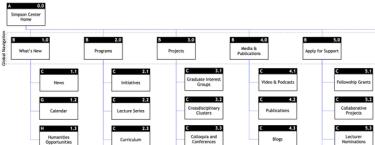
Site Maps & Connected Content
At the IA Summit earlier this year I had the pleasure of chatting with the brilliant and affable Carrie Hane over lunch about structured content, prototyping, and connected data approaches to IA. One of the things that had us both in a bit of a quandary was what to do about “the site map.” Being an “organizer,” that neat hierarchy of tidy boxes and connections has a lot of appeal. And clients love them: they get to see where all their stuff goes! But when designing large scale digital content organization systems (you know, “websites”) for dynamic, evolving collections of content, creating that map of “where everything goes” seems to have become, in equal measures, increasingly laborious, and increasingly short lived.
After some fruitful pondering over caffeine (read: coffee too late in the day so I couldn’t fall asleep last night), I think I’ve finally put my finger on why my trust in sitemaps as a tool for modern IA has been faltering: A site map articulates a set of rules for organizing content without exposing and expressing those rules clearly. The rules may be tacitly understood by the IA behind the drawing tool, and implicit in the content at hand, but a site map is one pass at those rules in action. It is the expression of a moment in time.
A content model, on the other hand, expresses the structure of a content domain, informed by business and user goals, and provides the rules for articulating that structure across a range of contexts — websites, natural language interfaces, intelligent agents, etc. We learned much of what we know about how websites go together from the world of publishing, and there’s at least one more good metaphor there: if a site map is an edition or issue, a content model is the editorial board.
As the systems of information for which we design get more complex and more fluid (hospitals, government, and higher education are all good examples), it is increasingly important that we explicitly express the rules that underly the visible structures we deliver. So where does this leave us with site maps? They’re still effective communication tools (and clients do love them), but I think we’ve moved beyond the point where they’re a foundation of information architecture. I’ll likely still include them to explain where my design recommendation stands at the moment, but the core of that recommendation will be rooted in the structure of the content itself.
(Credit where credit is due: For more on Structured and Connected Content, I can’t recommend highly enough Carrie Hane’s and Mike Atherton’s Designing Connected Content.)